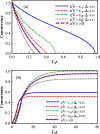Robust entanglement of an asymmetric quantum dot molecular system in a Josephson junction
- PMID: 32743096
- PMCID: PMC7387828
- DOI: 10.1016/j.heliyon.2020.e04484
Robust entanglement of an asymmetric quantum dot molecular system in a Josephson junction
Abstract
We demonstrate the generation of robust entanglement of a quantum dot molecular system in a voltage-controlled junction. To improve the quantum information characteristics of this system, we propose an applicable protocol which contains the implementation of asymmetric quantum dots as well as the engineering of reservoirs. Quantum dots can provide asymmetric coupling coefficients due to the tunable energy barriers through the gap voltage changes. To engineer the reservoirs, superconducting leads are used to prepare a voltage-biased Josephson junction. The high-controllability properties of this system give the arbitrary magnitude of entanglement by the arrangement of parameters. Significantly, the perfect entanglement can be achieved for an asymmetric structure in response to the increase of bias voltage, and also it continues saturated with the near-unit amount.
Keywords: Josephson junction; Quantum dot molecule; Quantum entanglement; Quantum mechanics; Quantum transport; Superconductors.
© 2020 Published by Elsevier Ltd.
Figures







References
-
- Peres A. Springer Science and Business Media; 2006. Quantum Theory: Concepts and Methods.
-
- Bennett C.H., DiVincenzo D.P., Smolin J.A., Wootters W.K. Phys. Rev. A. 1996;54:3824. - PubMed
-
- Werner R.F. Phys. Rev. A. 1989;40:4277. - PubMed
-
- Alber G., Beth T., Horodecki M., Horodecki P., Horodecki R., Rötteler M., Weinfurter H., Werner R., Zeilinger A. Springer; Berlin Heidelberg: 2003. Quantum Information: An Introduction to Basic Theoretical Concepts and Experiments.
-
- Nielson M.A., Chuang I.L. 2000. Quantum Computation and Quantum Information.
LinkOut - more resources
Full Text Sources
Miscellaneous

